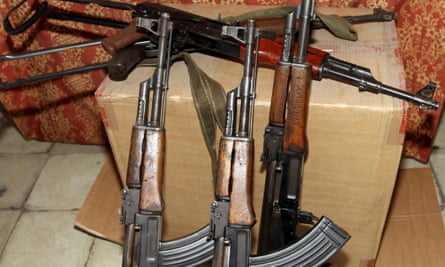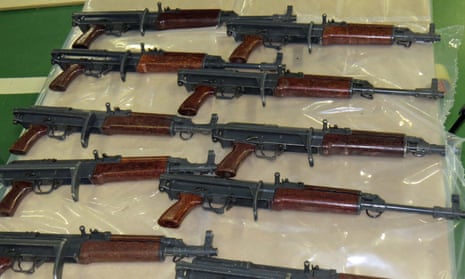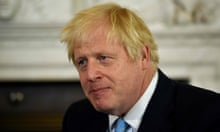An “arms race” between criminal groups in Europe risks making it easier for terrorists to obtain high-powered, military grade firearms, a report has warned.
The survey says long-standing barriers to obtaining firearms have broken down in recent years owing to the emergence of the internet, cross-border smuggling of military-grade assault rifles into the EU, the conversion of large numbers of blank-firing guns and the widespread reactivation of weapons previously rendered unusable to be sold to collectors.
“The increased availability of firearms has contributed to arms races between criminal groups across the EU,” the report, funded by the European commission, said.
TimelineThe Paris and Brussels attacks
Show
130 people are killed in coordinated attacks in Paris at the national stadium, bars, restaurants and the Bataclan concert hall. Seven of the 10-string kill themselves or are killed: two gunmen who shot dead scores on the streets of the 10th and 11th arrondissements go into hiding north of Paris while Saleh Abdeslam flees to Belgium. He told investigators he had been supposed to blow himself up at the Stade de France but backed out at the last minute.
Abdelhamid Abaaoud, the suspected ringleader, is killed with 13 November gunman Chakib Akrouh and his cousin, Hasna Aitboulahcen, in a dawn police assault on a slum flat in Saint-Denis where he was believed to be plotting an attack on the Paris business district of La Défense
Four police are wounded and an Algerian suspect killed in a gun battle at at an apartment in the Forest suburb of Brussels, where Abdeslam had been hiding. He escapes over the rooftops.
Abdeslam is captured in a raid on an address in the Molenbeek area of Brussels close to his family home. Belgian authorities say he told investigators he was planning a fresh attack in the capital.
Coordinated suicide attacks at Brussels airport and on the metro system kill 32 people. The bombers include Najim Laachraoui, named the previous day as a suspect in the Paris attacks, possibly as the bombmaker, and Khalid el-Bakraoui, who was also suspected of playing some kind of logistics role in the Paris attacks.
An alleged surviving member of the Brussels attackers, Mohamed Abrini, is arrested in Brussels. Investigators said he confessed to being the third man caught on video with suicide bombers at Brussels airport. A childhood friend of Abdeslam, he was also filmed driving a Renault Clio days before it was used in the Paris attacks.
In recent years, extremist attacks in France, Belgium, Denmark, Sweden and elsewhere have involved firearms. In the UK, plots involving firearms have been broken up by police and security services.
Militants from the Islamic State used automatic weapons and bombs to kill more than 130 people in bars, outside a stadium and at a concert hall in Paris in November 2015 in the bloodiest such incident.
Other uses of firearms in recent years have included lethal shootings at a museum in Brussels in 2014, the attack on the offices of a satirical magazine and a Jewish supermarket in Paris in January 2015, a series of attacks on off-duty soldiers and Jewish targets in south-west France in 2012 and at a synagogue in Denmark in 2016.
Attackers frequently have used “reactivated” and converted weapons, or firearms stolen from legitimate owners.
The attacks in Paris involved automatic weapons originally from former military stockpiles in the Balkans that had ended up in the hands of criminals in Belgium.
The report noted that in Paris it was firearms – “primarily automatic AK-pattern assault rifles and handguns acquired from intra-European criminal sources” – that had caused the vast majority of casualties.

“In western Europe the traditional closed character of criminal gun markets has partially eroded in recent years and we have observed an increased availability of military-grade firearms. These weapons have then also ended up in hands of terrorists,” said Nils Duquet, the editor of the report and a senior researcher at the Flemish Peace Institute, an independent research institute that coordinated the study.
Two trends particularly worry researchers: the “trickling-down” of the possession and use of firearms to lower-level criminals in several EU member states, especially in western Europe, and the growing overlap between Islamic extremists and the criminal underworld.
The phenomenon of “gangster jihad” has become a major concern for experts and security services.
Many high-profile attacks in Europe and the UK in recent years have involved extremists previously convicted for petty or serious crime.
Several key members of the network that carried out the November 2015 Paris attack had been involved in drug and arms sales.
Extremist recruitment efforts have specifically targeted former criminals, with one British group’s propaganda image of a fighter accompanied by the slogan: “Sometimes the people with the worst pasts create the best futures”.
The report concluded that terrorists generally rely on previously established criminal connections to obtain firearms on illicit markets. It identified prisons as places that offered new opportunities for extremists who did “not yet have the necessary criminal connections to acquire firearms”.
Laws and policies have been tightened in recent years to reinforce the fight against illicit arms trafficking.
However, the report said a lack of sound research meant these initiatives had often been based on a “case-bound, partial or even completely lacking, meaningful intelligence picture”.

The situation in the UK is different, researchers found, but Duquet said there were growing fears of smuggling of powerful automatic weapons to the UK.
“A number of recent cases, for example, have demonstrated that criminals have been trying to bring military-grade firearms to the UK by exploiting legal loopholes in other EU member states with regard to easy-to-reactivate deactivated firearms,” he said.
According to a separate report, also released on Tuesday, by analysts at the Geneva-based Small Arms Survey, criminal and terrorist networks on the continent obtain firearms from two major sources: weapons smuggled from south-east Europe after the Yugoslav wars of the 1990s, and the more recent trade in converted firearms, some of which originate in EU member states.
Converted and reactivated weapons in Europe are seen as having posed an acute problem in recent years. Amedy Coulibaly, who carried out shootings in Paris in January 2015, used two reactivated automatic rifles and and six handguns. The firearms had been sold in Slovakia before being reactivated and eventually smuggled into Coulibaly’s hands.
Weapons seized from Mohamed Merah, who carried out attacks in January 2012 in Toulouse and Montauban, included a reactivated Spanish-made pistol. The perpetrator of the July 2016 shooting in Munich reportedly used a reactivated Glock pistol purchased on the dark web.
Such weapons are smuggled in small quantities, sometimes just components that are later reassembled.










